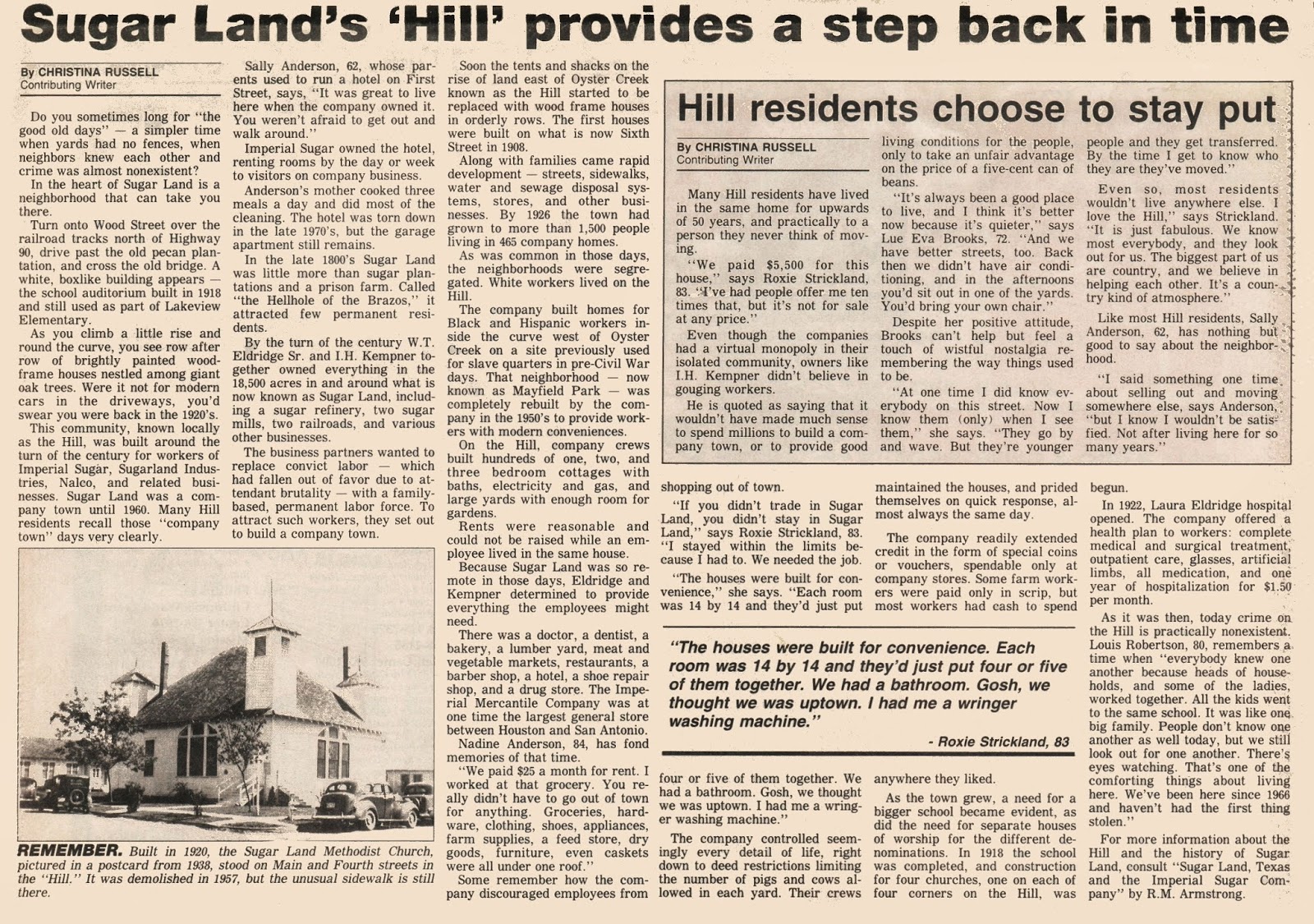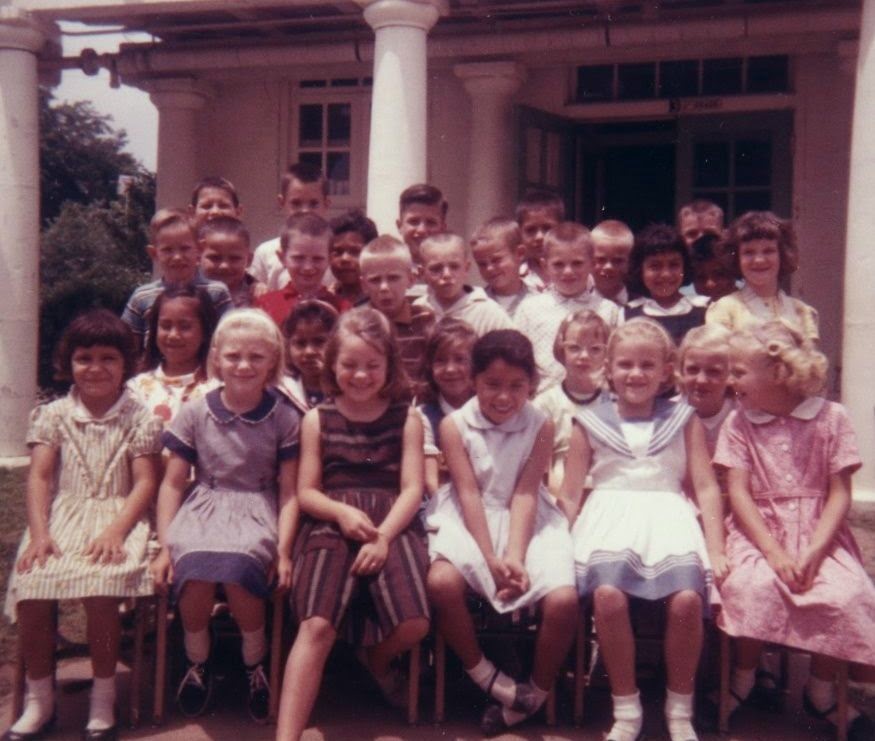Last time I posted a few stories from The Texas Industrial and Commercial News printed here in Sugar Land on Friday, August 29, 1919 -- pretty close to 100 years ago. Here are a few articles printed 2-weeks later on September 12th.
The first one recounts airplane rides given by a Mr. Cleveland (no first name). I'm reasonably sure he's either the son, grandson, or nephew of William Davis Cleveland for whom Cleveland Lake is named. The elder Cleveland was a prominent Houston businessman and connected to the Terry family and Edward Cunningham. He's an interesting story, and I'll try to dig up more details in the future.
It sounds as if young Mr. Cleveland used the dairy pasture, where Constellation Field is now located, as an air strip. Or maybe he used the empty field directly opposite on the south bank of Oyster Creek.
This transcription is easier to read:
Ride Airship
Mr. Cleveland, who has been an instructor at Ellington Field and who is now connected with a company that is promoting flying, was in Sugar Land Tuesday afternoon and Wednesday morning with one of the company planes and gratified the flying aspirations of about two dozen of our citizens.
Among those who went up with Mr. Cleveland were: Bob Hairston, Buddy Boehm, P. E. Flewellen, Mrs. P. E. Flewellen, little Miss Marjorie Flewellen, E. E. Edwards, Mrs. E. E. Edwards, Ben Ross, A. B. Spires, Frank Weiser, Gaylor Deatherage, Dr. S. C. Deatherage, Ed Chandler, Jack Stafford, Steve O'Connor, Jim Guyer, Carroll Scarborough, Earl Cantrell, Harry Redan, Miss Violet Darkes, Mrs. Jack Stafford, Miss Edith Lavendr, Miss Margaret Wright, Miss Inez Gill, and several of these went up more than once. Mr. Redan sent the mechanician (sic) up the second trip in an effort to get photographs of this vicinity from the altitude of the plane.
Mrs. Edwards speaking of her experience said it was perfectly delightful and except for the instant of beginning descent was not exciting a bit. She expected a bump on landing but instead says the landing was easy as stopping a car.
Miss Inez Gill is talking about buying her a plane of her own she is so enthusiastic about the flying game.
The next article follows up the story about the reopening of the Imperial Inn. Notice some guests missed the dinner party because their car was stuck in mud in Missouri City.
A transcription:
Mr. and Mrs. Brauner Give Banquet To Their Friends
On Tuesday evening, Mr. G. Brauner, manager of the Imperial Inn, and Mrs. Brauner tendered a special reception to a few of their friends of Sugar Land and Houston. Twenty covers were laid but owing to their car getting stuck in the mud at Missouri City, three of the guests did not arrive. Those in attendance enjoyed one of the most splendidly appointed dinners. Mr. and Mrs. Brauner personnaly superintended the preparations and no detail was incomplete. The beautiful new dining room was decorated tastefully, and the new service equipment was superb and the newly organized waiter service was all that could be asked. The menu, consisting of Queen Olives, Broiled Red fish, French Fried Potatoes, Sliced Tomatoes, Fried Chicken, Creamed Potatoes, English Peas, Asparagus, Ice Cream and Coffee had been so skillfully prepared and was so gracefully served that the guests could hardly realize they were not in a large city where every possible convenience and delicacy were available.
The Inn has just been remodeled and renovated and a spacious dining room added as well as tea rooms and other conveniences of modern hostelry. The furnishings and lighting are quite appropriate and of a simple elegance that gives the guest that home like feeling so much desired. A good dancing floor is also a feature and the management plans its liberal use. Guests arriving early were shown over the grounds and through the elaborate poultry yards and pigeon cotes. During the summer months when the Inn has been closed, Mr. and Mrs. Brauner have devoted their attention to poultry with results that should be highly gratifying. Their chickens look like show birds but they are destined just the same to furnish the piece de resistance for many a sumptuous meal at the Inn.
Following the dinner, a colored string band from the State Farm began pouring forth strains of music from an alcove and soon most of the guests were dancing in unison. The (convicts) sang plantation melodies and popular airs, supplying a delightful close to the evening's entertainment.
The host and hostess received the congratulations of the guests and the heartiest thanks for an evening of such genuine good cheer. Covers were laid for: Mr. and Mrs. Bond and Mr. Covington of Houston, Mr. and Mr. W. T. Eldridge, Jr., Mr. and Mrs. G. D. Ulrich, Mr. and Mrs. Stanley Blum, Mr. and Mrs. A. M. Waugh, Mr. and Mrs. J. J. Whatley and Miss Juanita Emery of Houston, Mr. and Mrs. E. E. Edwards, Mr. Guenther, Mr. Jackson, and Mr. and Mrs. Brauner.
The next story announces the organization of the Sugar Land Methodist Church, now Sugar Land First United Methodist Church.
A transcription:
Methodists Organize - Officers Are ElectedTo Hold Services Every Sunday in School AuditoriumAll Not Obligated to Attend Other Religious Services Are Urged to Attend and Take Part
On last Sunday at 2 p.m. in the Auditorium Rev. C. E. Clark, Methodist missionary evangelsit for the Houston district preached and following the sermon reorganization of the Methodists congregation at this place was made. Members of the former organization here together with other Methodists participated in the organization and the following officers were elected:
Trustees: C. J. Berney, C. E.
Vellenga, and A. M. McMeans.
Clerk: Miss Lois McGee.
Stewards: C. J. Berney, Mrs. C. A. Dierks, Mrs. C. E. Vellenga, A. M. McMeans, A. D. Jackson.
Announcement was made that services would be held every Sunday, Rev. Clark to preach two Sundays each month and the other two or three Sundays to be filled by other preachers the Presiding Elder may be able to secure until Conference meets in November, after which it is intended to have a regular resident pastor assigned to the charge. It was also announced that at present no Sunday School or League would be organized, but both organizations are to be perfected as soon as same may be found practicable. Those present were urged to get into communication with all residents of Sugar Land desiring to affiliate with the Methodist Church and ask their attendance and cooperation. It is also desired that every one attend those services when not obligatd to participate ini other meetings at the same time.
Rev. Clark in is discussion of the advisibility of organizing active work here urged that no proselytizing be don, but pointed out that active work by the Methodists should bring into play much new timber in the church life of the community. He expressed the hope that the other denominations already at work here would pursue their activities with increased vigor which, coupled with vigorous work by the Methodists should make ample room for every one so inclined to take active part in religious work, it being pointed out that of several hundred white employees of the Industries there are probably fewer than a hundred taking an active part in church work.
Song books were ordered and a choir is to be organized at once and regular meeting for choir practice will be held on week nights. Prayer meetings will be also held regularly, announcement of the beginning of which si to be made later.


















































